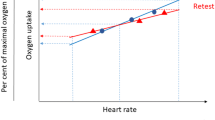Abstract
The maximum oxygen intake of nine male subjects was determined on a step-test and while they were working at maximum rates on tramming and on the treadmill. For all tasks three repeated measurements of oxygen intake and heart rates were made at each level of work. Estimates of the maximum oxygen intake of the nine men, based on the data obtained from laboratory tasks such as running on the treadmill and stepping on and off a stool 12 inches high, were very similar to estimates based on an industrial task such as tramming a mine car. Results obtained during treadmill running and tramming agreed more closely with each other than the data obtained during the stepping test agree with those obtained from either the treadmill or tramming. Use of the individual's own maximum heart rate (obtained during the treadmill tests) improved estimates of maximum oxygen intake for the step-test, whereas the use of the group mean heart rate of 184 beats/min, instead of 180 beats/min, improved estimates even further.
Similar content being viewed by others
References
Asmussen, E., andI. Hemmingsesn: Determination of maximum working capacity at different ages in work with the legs or with the arms. Scand. J. clin. Lab. Invest.10, 67 (1958).
Astrand, P. O.: Experimental studies of physical working capacity in relation to sex and age. Copenhagen: Munksgaard 1952.
Christensen, E. H., andP. Hogberg: Physiology of skiing. Arbeitsphysiologie14, 292 (1950).
Duner, H.: Oxygen uptake and working capacity of man doing work on the bicycle ergometer with one leg and both legs. Acta physiol. scand.46, 55 (1959).
Maritz, J. S., J. F. Morrison, J. Peter, N. B. Strydom, andC. H. Wyndham: A practical method of estimating an individual's maximum oxygen intake. Ergonomics4, 97 (1961).
Taylor, M. L., E. Buskirk, andA. Henschel: Maximal O2 intake as an objective measure of cardio respiratory performance. J. appl. Physiol.8, 73 (1955).
Wyndham, C. H., N. B. Strydom, W. P. Leary andC. G. Williams: A comparison of methods of assessing the maximum oxygen intake. Int. Z. angew. Physiol.22, 285–295 (1966).
—,C. G. Williams andM. V. Rahden: A physiological basis for the optimum level of energy expenditure. Nature (Lond.)195, 1210 (1962).
—,C. G. Williams, J. F. Morrison andM. Watson: The maximum oxygen intakes of men working on industrial tasks. Int. Z. angew. Physiol.22, 141–148 (1966).
Author information
Authors and Affiliations
Rights and permissions
About this article
Cite this article
Williams, C.G., Wyndham, C.H., du Raan, A.J.N. et al. A comparison of the physical work capacity of individuals as determined by various tasks. Int. Z. Angew. Physiol. Einschl. Arbeitsphysiol. 24, 102–110 (1967). https://doi.org/10.1007/BF00698326
Received:
Issue Date:
DOI: https://doi.org/10.1007/BF00698326




